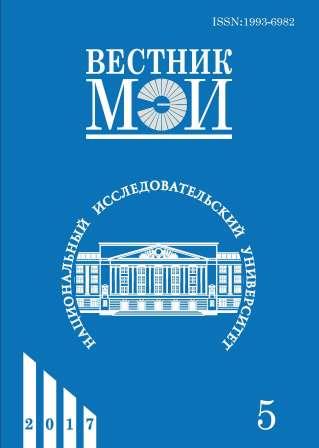Марковская модель изменения шероховатых поверхностей при механическом взаимодействии
Аннотация
Описан общий подход к построению модели взаимодействия шероховатых поверхностей, приводящий к анализу марковского процесса. Дано новое обоснование марковости. Поверхность представляется случайной, состоящей из совокупности элементов (неровностей, выступов) со случайными состояниями. Элементы поверхностей, контактируя между собой, меняют друг друга. При различных конкретизациях того, что есть состояние элемента (выступа) и что есть функции взаимодействия двух элементов, можно получить описание различных взаимодействий (механических, тепловых, электрических) всей поверхности. Подход приводит к марковскому процессу с рекуррентным во времени пересчетом распределения вероятностей для его состояний. По распределению вероятностей можно оценивать во времени различные характеристики взаимодействия. Подход применяется к процессу трения. Любой выступ одной поверхности подвергается воздействию движущихся выступов другой со случайными состояниями (высотами). Взаимодействие выступов (в результате механического контакта) происходит только между самыми высокими и при контакте выступ изменяется с весьма малой вероятностью. По этой причине предполагается, что поток изменений любого элемента поверхности является пуассоновским. Следующее состояние — результат взаимодействия предыдущего состояния и очередного воздействия некоторым выступом другой поверхности. Результат описывается известной функцией взаимодействия. Если последовательные воздействия — независимые случайные величины, то процесс изменений состояния является марковским, и потому распределение рекуррентно пересчитывается, причем переходные вероятности зависят от распределения высот другой поверхности. Поскольку влияние поверхностей взаимно, аналогичный пересчет справедлив и для любого выступа другой поверхности. Таким образом, имеет место пересчет двух распределений, где оператор пересчета одной поверхности зависит от распределения другой. Характеристики трения в любой момент времени определяются по распределениям. Подход конкретизирован к режиму усталостного разрушения, при котором элемент поверхности разрушается после многократных контактов порядка многих миллионов. Обоснован выбор интервала дискретизации пересчета распределений, существенно ускоряющий численный анализ модели ценой изменения матрицы переходных вероятностей. Выписаны уравнения Колмогорова – Феллера для модели усталостного разрушения. В качестве примера применения модели контактного взаимодействия проанализирован процесс изнашивания направляющей поршня в дизеле ЧН 13/15 и выполнена оценка триботехнических параметров, определяющих ресурс сопряжения «поршень – цилиндр».
Литература
2. Тигетов Д.Г., Горицкий Ю.А. Марковская модель механического взаимодействия шероховатых поверхностей в процессе трения // Трение и смазка в машинах и механизмах. 2010. № 3. С. 3—12.
3. Горицкий Ю.А., Главатских С.Б., Бражникова Ю.С. Марковская модель взаимодействия шероховатых поверхностей // Трение и смазка в машинах и механизмах. 2014. № 2. С. 11—20.
4. Тигетов Д.Г. Разработка и исследование вероятностных моделей взаимодействия шероховатых поверхностей в процессе трения: дисс. ... канд. техн. наук. М.: Изд-во МЭИ, 2010.
5. Nayak P.R. Random Process Model of Rough Surfaces // J. Lubrication Tech. 1971. V. 93. Pp. 398—407.
6. Greenwood J.A., Williamson J.B.P. Contact of Nominally Flat Surfaces // Proc. Royal Soc. 1966. Ser. A. V. 295. Pp. 300—319.
7. Крагельский И.В., Добычин М.Н., Комбалов В.С. Основы расчетов на трение и износ. М.: Машиностроение, 1977.
8. Lazarev V., Gavrilov K., Doikin A., Vorlaufer G., Sequard-Base J. Estimation of the Tribotechnical Parameters of the Piston Skirt-cylinder Liner Contact Interface from an IC-engine for Decreasing the Mechanical Losses // WIT Trans. Ecology and Environment. 2014. V. 190. No. 1. Pp. 625—635.
9. Gavrilov K., Rozhdestvensky Y. Numerical and Experimental Investigations of Tribosystems of Piston Engines Taking into Account Boundary Lubrication Regime, Macro and Microgeometry of Contact Interface// Soc. of Tribologists and Lubrication Eng. Annual Meeting and Exhibition. 2014. No. 2. Pp. 583—585.
10. Goritskiy Yu.A. е. а. Numerical Model for Mechanical Interaction of Rough Surfaces of the Piston- cylinder Liner Tribosystem // FME Trans. 2015. V. 43. No. 3. Pp. 249—253.
11. Горицкий Ю.А., Тигетов Д.Г. Марковский процесс с непрерывным временем для описания механического взаимодействия шероховатых поверхностей // Вестник МЭИ. 2011. № 6. С. 112—125.
12. Горицкий Ю.А., Бражникова Ю.С. Уравнения и их решение для марковской модели упругопластического взаимодействия шероховатых поверхностей // Вестник МЭИ. 2013. № 6. С. 154—165.
---
Для цитирования: Горицкий Ю.А., Гаврилов К.В., Исмаилова Ю.С., Шевченко О.В. Марковская модель изменения шероховатых поверхностей при механическом взаимодействии // Вестник МЭИ. 2017. № 5. С. 101—110. DOI: 10.24160/1993-6982-2017-5-101-110.
#
1. Goritskiy Yu.A. O Markovskom Podhode k Modelirovaniyu Protsessa Treniya. Matematika Komp'yuter. Obrazovanie: Tez. dokl. konf. Dubna, 2008:63. (in Russian).
2. Tigetov D.G., Goritskiy Yu.A. Markovskaya Model' Mekhanicheskogo Vzaimodeystviya Sherohovatyh Poverhnostey v Protsesse Treniya. Trenie i Smazka v Mashinah i Mekhanizmah. 2010;3:3—12. (in Russian).
3. Goritskiy Yu.A., Glavatskih S.B., Brazhniko- va Yu.S. Markovskaya Model' Vzaimodeystviya She- rohovatyh Poverhnostey. Trenie i Smazka v Mashinah i Mekhanizmah. 2014;2:11—20. (in Russian).
4. Tigetov D.G. Razrabotka i Issledovanie Veroyat- nostnyh Modeley Vzaimodeystviya Sherohovatyh Poverh- nostey v Protsesse Treniya: Diss. ... Kand. Tekhn. Nauk. М.: Izd-vo. MPEI, 2010. (in Russian).
5. Nayak P.R. Random Process Model of Rough Surfaces. J. Lubrication Tech. 1971;93:398—407.
6. Greenwood J.A., Williamson J.B.P. Contact of Nominally Flat Surfaces. Proc. Royal Soc. 1966; A;295:300—319.
7. Kragel'skiy I.V., Dobychin M.N., Kombalov V.S. Osnovy Raschetov na Trenie i Iznos. М.: Mashinostroenie, 1977. (in Russian).
8. Lazarev V., Gavrilov K., Doikin A., Vorlaufer G., Sequard-Base J. Estimation of the Tribotechnical Parameters of the Piston Skirt-cylinder Liner Contact Interface from an IC-engine for Decreasing the Mechanical Losses. WIT Trans. Ecology and Environment. 2014;190;1:625—635.
9. Gavrilov K., Rozhdestvensky Y. Numerical and Experimental Investigations of Tribosystems of Piston Engines Taking into Account Boundary Lubrication Regime, Macro and Microgeometry of Contact Interface. Soc. of Tribologists and Lubrication Eng. Annual Meeting and Exhibition. 2014;2:583—585.
10. Goritskiy Yu.A. e. a. Numerical Model for Mechanical Interaction of Rough Surfaces of the Piston- cylinder Liner Tribosystem. FME Trans. 2015;43;3:249—253.
11. Goritskiy Yu.A., Tigetov D.G. Markovskiy Pro- tsess s Nepreryvnym Vremenem dlya Opisaniya Mekhanicheskogo Vzaimodeystviya Sherohovatyh Poverhnostey. Vestnik MPEI. 2011;6:112—125. (in Russian).
12. Goritskiy Yu.A., Brazhnikova Yu.S. Uravneniya i ih Reshenie dlya Markovskoy Modeli Uprugoplasticheskogo Vzaimodeystviya Sherohovatyh Poverhnostey. Vestnik MPEI. 2013;6:154—165. (in Russian).
---
For citation: Goritsky Yu.A., Gavrilov K.V., Ismailova Yu.S., Shevchenko O.V. The Markov Model for Alteration of Rough Surfaces during Their Mechanical Interaction. MPEI Vestnik. 2017;5:101—110. (in Russian). DOI: 10.24160/1993-6982-2017-5-101-110.




